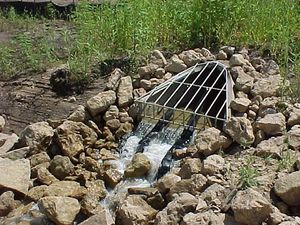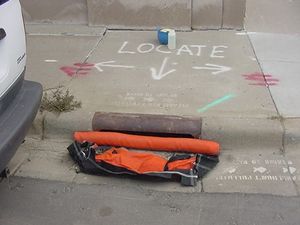
Difference between revisions of "Sediment control practices"
(Created page with "{{alert|This page is under development. We anticipate populating it in autumn, 2016.|alert-under-construction}} file:Applying mulch 1.jpg|300px|thumb||alt=photo of mulch ap...") |
m |
||
| (20 intermediate revisions by 3 users not shown) | |||
| Line 1: | Line 1: | ||
| − | + | [[file:Energy dissipation 1.jpg|300px|thumb||alt=photo of energy dissipation BMP|<font size=3>Energy dissipation using rock riprap.</font size>]] | |
| − | + | [[file:Tracking 1.jpg|thumb|300px|alt=photo of vehicle tracking pad|<font size=3>Properly constructed BMP for vehicle tracking.</font size>]] | |
| − | [[file: | + | [[file:Inlet protection 1.jpg|thumb|300px|alt=image of inlet protection|<font size=3>Example of proper inlet protection.</font size>]] |
| − | [[file: | ||
| − | [[file: | ||
Erosion is the process by which soil, rock, or other material is moved from one location to another, typically through the action of water or wind. Sediment control practices are designed to prevent or minimize loss of eroded soil at a site. Typical sediment control practices focus on the following. | Erosion is the process by which soil, rock, or other material is moved from one location to another, typically through the action of water or wind. Sediment control practices are designed to prevent or minimize loss of eroded soil at a site. Typical sediment control practices focus on the following. | ||
| Line 10: | Line 8: | ||
*Settling processes, that allow sediment to fall out of flows that are slowed and temporarily impounded in ponds, traps, or in small pools created by berms, silt fencing, inlet protection dikes, check dams, and so on | *Settling processes, that allow sediment to fall out of flows that are slowed and temporarily impounded in ponds, traps, or in small pools created by berms, silt fencing, inlet protection dikes, check dams, and so on | ||
| + | This page provides links to several pages in this manual that address sediment control at construction stormwater sites, as well as links to other pages and information related to erosion prevention practices. | ||
| − | + | [[Acknowledgements for construction stormwater|Acknowledgements]] | |
==Sediment control practices== | ==Sediment control practices== | ||
| Line 17: | Line 16: | ||
*[[Sediment control practices - Perimeter controls for disturbed areas]] | *[[Sediment control practices - Perimeter controls for disturbed areas]] | ||
*[[Sediment control practices - Check dams (ditch checks, ditch dikes)]] | *[[Sediment control practices - Check dams (ditch checks, ditch dikes)]] | ||
| − | *[[Sediment control practices - | + | *[[Sediment control practices - Diversion barrier controls (cofferdams/temporary dikes)]] |
*[[Sediment control practices - Storm drain inlet protection]] | *[[Sediment control practices - Storm drain inlet protection]] | ||
*[[Sediment control practices - Outlet energy dissipation]] | *[[Sediment control practices - Outlet energy dissipation]] | ||
| + | *[[Sediment control practices - Sediment traps and basins]] | ||
| + | *[[Sediment control practices - Stabilized earth/soil berm]] | ||
| + | *[[Sediment control practices - Buffer zones]] | ||
| + | *[[Sediment control practices - Pavement sweeping]] | ||
| + | *[[Construction stormwater practices - diversion and working in the dry]] | ||
| + | *[[Construction stormwater treatment - dewatering, including chemical treatment and sediment filtration]] | ||
| + | *[[Construction stormwater best management practice – buffer zones]] - Note this is a short fact sheet on the topic. For detailed information, see [[Sediment control practices - Buffer zones]] | ||
==Photo galleries== | ==Photo galleries== | ||
| + | *[http://stormwater.pca.state.mn.us/index.php/Construction_stormwater_photo_gallery_-_Stabilization Stabilization practices] | ||
| + | *[[Construction stormwater photo gallery - Perimeter control|Perimeter control]] | ||
| + | *[[Construction stormwater photo gallery - Vehicle tracking BMPs|Vehicle tracking BMPs]] | ||
| + | *[[Construction stormwater photo gallery - Outlet energy dissipation|Outlet energy dissipation]] | ||
| + | *[[Construction stormwater photo gallery - Check dams (ditch checks, ditch dikes)|Check dams (ditch checks, ditch dikes)]] | ||
| + | *[[Construction stormwater photo gallery - Storm drain inlet protection|Storm drain inlet protection]] | ||
==Links== | ==Links== | ||
*[http://stormwater.pca.state.mn.us/index.php/Construction_stormwater_program Main construction stormwater page] | *[http://stormwater.pca.state.mn.us/index.php/Construction_stormwater_program Main construction stormwater page] | ||
| + | *[https://stormwater.pca.state.mn.us/index.php?title=Erosion_prevention_practices Erosion prevention practices] | ||
*[[General principles for erosion prevention and sediment control at construction sites in Minnesota]] | *[[General principles for erosion prevention and sediment control at construction sites in Minnesota]] | ||
| + | *[[Construction stormwater best management practice – perimeter control fact sheet]] | ||
| + | *[https://www.pca.state.mn.us/sites/default/files/wq-strm2-36.doc Construction Stormwater Inspection Checklist] | ||
| + | *[https://www.pca.state.mn.us/sites/default/files/wq-strm2-68p.pdf Linear permanent stormwater management design flow chart] | ||
| + | *[[Construction stormwater best management practice – Concrete, paint, stucco and other washout guidance]] | ||
| + | *[https://www3.epa.gov/npdes/pubs/concretewashout.pdf EPA Concrete Washout Stormwater Best Management Practice] | ||
| + | *[[Construction stormwater best management practice – buffer zones]] | ||
| + | *[[Construction stormwater best management practice – Site stabilization]] | ||
| + | *[[Construction stormwater – Top 5 permit violations]] | ||
==Permit applicability== | ==Permit applicability== | ||
{{alert|The Construction Stormwater General permit states "The Permittee(s) must stabilize all exposed soil areas (including stockpiles)." For more specific information, see [http://stormwater.pca.state.mn.us/index.php/IV._CONSTRUCTION_ACTIVITY_REQUIREMENTS#IV.B._EROSION_PREVENTION_PRACTICES Part IV.B.2] of the permit.|alert-danger}} | {{alert|The Construction Stormwater General permit states "The Permittee(s) must stabilize all exposed soil areas (including stockpiles)." For more specific information, see [http://stormwater.pca.state.mn.us/index.php/IV._CONSTRUCTION_ACTIVITY_REQUIREMENTS#IV.B._EROSION_PREVENTION_PRACTICES Part IV.B.2] of the permit.|alert-danger}} | ||
| + | <noinclude> | ||
| + | [[Category:Level 3 - Best management practices/Construction practices/Sediment control practices]] | ||
| + | </noinclude> | ||
Latest revision as of 13:08, 21 March 2023
Erosion is the process by which soil, rock, or other material is moved from one location to another, typically through the action of water or wind. Sediment control practices are designed to prevent or minimize loss of eroded soil at a site. Typical sediment control practices focus on the following.
- Physical filtration of sediment by trapping soil particles as water passes through a silt fence, drop inlet screen, fiber roll, etc.
- Settling processes, that allow sediment to fall out of flows that are slowed and temporarily impounded in ponds, traps, or in small pools created by berms, silt fencing, inlet protection dikes, check dams, and so on
This page provides links to several pages in this manual that address sediment control at construction stormwater sites, as well as links to other pages and information related to erosion prevention practices.
Sediment control practices
- Sediment control practices - Vehicle tracking BMPs
- Sediment control practices - Perimeter controls for disturbed areas
- Sediment control practices - Check dams (ditch checks, ditch dikes)
- Sediment control practices - Diversion barrier controls (cofferdams/temporary dikes)
- Sediment control practices - Storm drain inlet protection
- Sediment control practices - Outlet energy dissipation
- Sediment control practices - Sediment traps and basins
- Sediment control practices - Stabilized earth/soil berm
- Sediment control practices - Buffer zones
- Sediment control practices - Pavement sweeping
- Construction stormwater practices - diversion and working in the dry
- Construction stormwater treatment - dewatering, including chemical treatment and sediment filtration
- Construction stormwater best management practice – buffer zones - Note this is a short fact sheet on the topic. For detailed information, see Sediment control practices - Buffer zones
Photo galleries
- Stabilization practices
- Perimeter control
- Vehicle tracking BMPs
- Outlet energy dissipation
- Check dams (ditch checks, ditch dikes)
- Storm drain inlet protection
Links
- Main construction stormwater page
- Erosion prevention practices
- General principles for erosion prevention and sediment control at construction sites in Minnesota
- Construction stormwater best management practice – perimeter control fact sheet
- Construction Stormwater Inspection Checklist
- Linear permanent stormwater management design flow chart
- Construction stormwater best management practice – Concrete, paint, stucco and other washout guidance
- EPA Concrete Washout Stormwater Best Management Practice
- Construction stormwater best management practice – buffer zones
- Construction stormwater best management practice – Site stabilization
- Construction stormwater – Top 5 permit violations
Permit applicability
Warning: The Construction Stormwater General permit states "The Permittee(s) must stabilize all exposed soil areas (including stockpiles)." For more specific information, see Part IV.B.2 of the permit.
This page was last edited on 21 March 2023, at 13:08.

